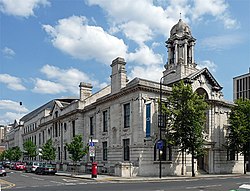Bethnal Green (parish)
| Bethnal Green | |
|---|---|

Bethnal Green Town Hall
|
|
 Bethnal Green within the County of London |
|
| Area | |
| • 1911/1961 | 759 acres (3.07 km2) |
| • 1931 | 760 acres (3.1 km2) |
| Population | |
| • 1911 | 128,183 |
| • 1931 | 108,194 |
| • 1961 | 47,078 |
| Density | |
| • 1911 | 169/acre |
| • 1931 | 142/acre |
| • 1961 | 62/acre |
| History | |
| • Origin | Hamlet in parish of Stepney |
| • Created | 1743 |
| • Abolished | 1965 |
| • Succeeded by | London Borough of Tower Hamlets |
| Status |
Civil parish (1743–1965) Poor law parish (1834–1930) Metropolitan borough (1900–1965) |
| Government | Vestry of the Parish of Bethnal Green (1743–1900) Bethnal Green Borough Council (1900–1965) |
| • HQ | Patriot Square |
 Borough seal |
|
Bethnal Green was a civil parish and a metropolitan borough in the East End of London, England.
It was formed as a civil parish in 1743 from the Bethnal Green hamlet in Stepney ancient parish, and the church of St Matthew, Bethnal Green was dedicated in 1746.
The vestry became an electing authority to the Metropolitan Board of Works in 1855 and in 1889 it became part of the County of London. In the 1900 reform of local government caused by the London Government Act 1899 the parish became a metropolitan borough which bordered Hackney, Poplar, Stepney and Shoreditch. In 1965 it was abolished and merged into the London Borough of Tower Hamlets.
Until 1743 Bethnal Green formed a hamlet within the large parish of Stepney. By the 17th century the settlement had achieved a measure of self-government, with its own overseer, constable and beadle. It remained a rural area until the beginning of the 18th century, when the expansion of suburban London saw the development of the Brick Lane area in the south west of the hamlet. The population rapidly increased and in 1743 an act of parliament constituted Bethnal Green as a separate parish. As well as forming a parish for ecclesiastical purposes, Bethnal Green was also created a civil parish with responsibility for relief of the poor and maintenance of highways. The government of the parish was shared by a vestry, governors of the poor and two separate bodies of trustees. A further board of paving and lighting commissioners were established in 1843.
...
Wikipedia
